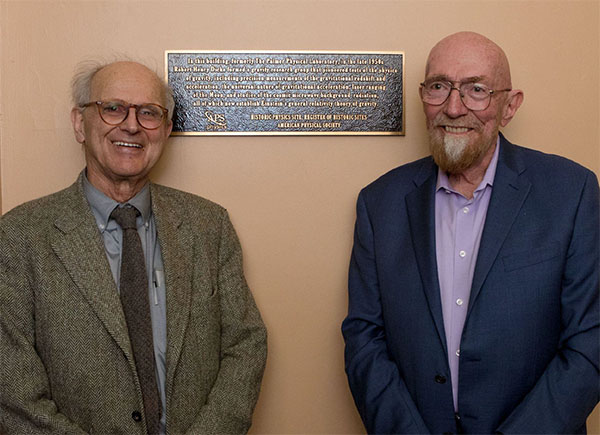Palmer Physical Laboratory
Princeton University
Princeton, New Jersey
Palmer Physical Laboratory is the site of Robert Dicke's innovations in atomic physics and spectroscopy. To commemorate his contributions to physics, on April 12, 2018, former APS President Curtis Callan dedicated a Historic Sites plaque honoring Dicke's work at Princeton University in the 1950s and 1960s. As part of the dedication ceremony, several of Dicke's colleagues and students spoke about his contributions to physics.
Dicke received his BS from Princeton in 1939 and his PhD from the University of Rochester in 1941. During World War II he worked at the MIT Radiation Laboratory, where he developed the Dicke Radiometer, a device for accurately measuring microwave radiation. In 1946 he went back to Princeton to concentrate on atomic physics and spectroscopy. One of his important contributions is his prediction of the phenomenon of Dicke narrowing, in which the spectral linewidth of a radiative transition could shrink in response to atomic collisions. He switched directions in the late 1950s to astrophysics and cosmology, working on ways to carry out precise tests of general relativity.
In the 1960s, Dicke and P. James Peebles, among others, worked out a prediction that the radiation left over from the early universe could be experimentally observed. Following that, Dicke and his colleagues David Wilkinson and Peter Roll built an instrument based on his radiometer design to look for evidence of the cosmic microwave background. Ironically, Arno Penzias and Robert Wilson, also using a Dicke radiometer instrument, were first to win the race to detect the primordial microwaves for which they received the 1978 Nobel Prize in physics.
In view of Dicke's extensive contributions to this and other areas of physics, the APS Historic Sites committee selected the Palmer Physical Laboratory to receive a plaque, installed at the Frist Campus Center on the Princeton Campus. This building was originally the Palmer Physical Laboratory, where Dicke had his office and laboratories. Among those speaking at the dedication were P. James Peebles (Princeton), Rainer Weiss (Nobel Laureate, MIT), Herman Verlinde (Princeton), Curtis Callan (Princeton), Lyman Page (Princeton), Suzanne Staggs (Princeton), William Wickes (former PhD student), and Paul Boynton (former PhD student).

Credit: Princeton University, Office of Communications, Denise Applewhite
Rainer Weiss, left, and Kip Thorne
